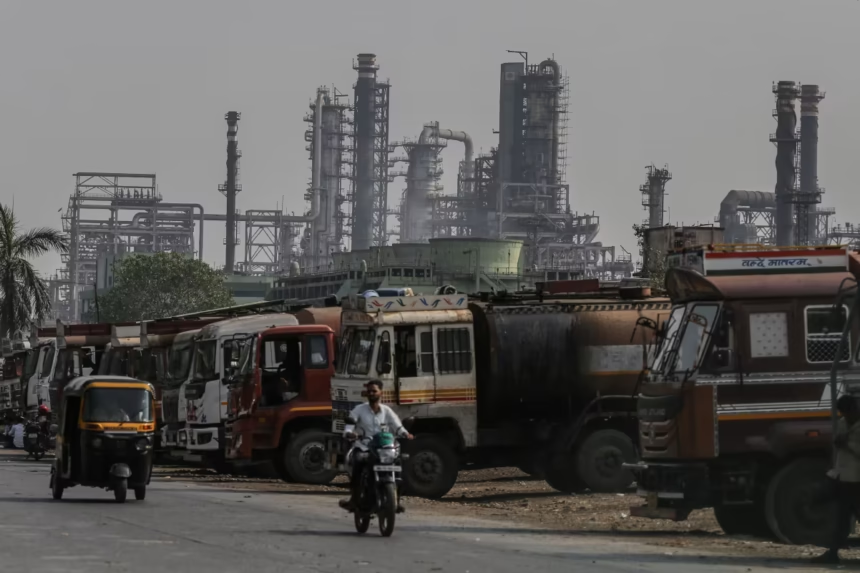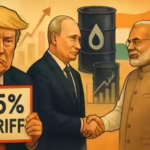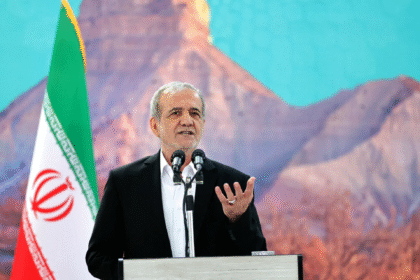The Oil That Burned Bridges — India, Russia, and Trump’s Trade Threats
In a world already rattled by geopolitical flux, the resurgence of Donald J. Trump into the center of U.S. foreign policy discourse has once again stirred anxieties across global markets. His latest warning — a sharp and public threat to impose tariffs on India for its continued import of Russian oil — has sparked a chain of speculation, strategy reassessment, and diplomatic calculation.
To understand the stakes of Trump’s tariff threat, one must first look beyond the soundbites and into the underlying structure of global oil trade, U.S.-India relations, and the long shadow of the Russia-Ukraine war.
India’s Energy Gamble: Cheap Oil, Costly Optics
Since the start of the Ukraine war in 2022, India has emerged as one of the largest purchasers of discounted Russian crude. What started as a pragmatic economic decision — buying oil at below-market rates amidst global inflation — soon evolved into a geopolitical statement. While the West rallied behind sanctions on Moscow, New Delhi chose energy security over alignment, emphasizing that India’s national interests would guide its foreign policy.
It worked. India secured oil at prices far lower than its traditional suppliers in the Gulf. By the end of 2023, Russia had become India’s top oil supplier, overtaking even Iraq and Saudi Arabia. The move helped India keep inflation in check and supported its post-pandemic recovery.
But in Washington — particularly in Republican circles — this independence hasn’t gone unnoticed. Trump, now vying for another shot at the presidency, is openly questioning why India, a strategic partner, is still funding a regime the West is trying to isolate.
Trump’s Strategy: Tariffs as a Pressure Tool
Trump’s trade strategy has always been more combative than cooperative. During his first presidency, he slapped tariffs on China, threatened Mexico, and even targeted allies in the EU. His foreign economic policy often mirrored his domestic posture: zero-sum, transactional, and highly theatrical.
By threatening tariffs on India, Trump is signaling that under his leadership, no country — not even long-standing partners — would get a free pass. The logic is simple: if India continues to strengthen Russia’s hand by purchasing oil, it should face economic consequences. His message appeals to his base and reasserts his tough stance on China and Russia without involving U.S. troops or new wars.
India’s Dilemma: Balancing East and West
India finds itself in a delicate position. On one hand, it values its strategic partnership with the United States — including defense deals, semiconductor investments, and geopolitical alignment in the Indo-Pacific. On the other hand, Russia remains a legacy partner — especially in defense procurement and energy.
Prime Minister Narendra Modi’s administration has walked this tightrope deftly so far. But Trump’s new posture could force New Delhi to make uncomfortable recalibrations. If tariffs were to be enacted on Indian exports — especially in textiles, pharmaceuticals, or IT services — the economic fallout could be significant.
Global Implications: A Return to Trumpism?
While Trump is not yet in office, his influence over the Republican Party and U.S. foreign policy debates remains dominant. His statement is already being dissected in capitals across the world. Would a Trump 2.0 presidency mean renewed trade wars? Would NATO allies face pressure to cut ties with Russia more aggressively? Could India become collateral in a larger anti-China/Russia containment agenda?
Already, India’s Ministry of External Affairs has responded cautiously, stating that its oil purchases are legal, transparent, and in line with its energy needs. Behind closed doors, however, policymakers are bracing for turbulence.
India’s import of Russian crude oil is not just a story of economics or diplomacy — it’s a story of adaptation, resilience, and the subtle art of strategic ambiguity. When sanctions tightened across the Western world, and dollar transactions became politically toxic, India didn’t step back. It adapted. Quietly, skillfully, and with a sharp eye on national interest.
In this part, we examine the intricate framework of India’s oil trade with Russia — from the ports of Primorsk to the refineries of Jamnagar — and how it silently transformed into one of the most discussed supply chains in global geopolitics.
The Pivot After the Ukraine War
Before 2022, India bought very little oil from Russia — just about 2% of its total imports. Most of its crude came from traditional partners: Iraq, Saudi Arabia, and the UAE. But after Russia’s invasion of Ukraine and the G7 sanctions, Russia began selling its crude at discounted rates, often 20–30% cheaper than Brent crude.
For an energy-hungry economy like India’s — growing at over 6% annually — this was a no-brainer. Indian refiners, both public and private, ramped up their purchases. By early 2024, Russia accounted for over 35% of India’s crude oil imports. In fact, Jamnagar and Vadinar refineries in Gujarat became key nodes in this rerouted energy map.
The trade was discreet but robust.
Payment Workarounds: Beyond the Dollar
One of the biggest hurdles India faced was how to pay. With most Russian banks cut off from SWIFT and U.S. dollars no longer viable, India began experimenting with alternatives.
- Rupee-Ruble Arrangement: Initially, talks centered around settling oil trades in Indian rupees or Russian rubles. But Russia was reluctant — the rupee wasn’t freely convertible, and holding large volumes posed risks.
- Third-Currency Route: India eventually settled on using the UAE Dirham and the Chinese Yuan, both of which were more acceptable to Russian exporters and could navigate financial restrictions without triggering Western oversight.
- Indian Banks and Cautious Steps: Indian banks were cautious not to run afoul of Western sanctions. Many deals were routed through smaller regional banks or non-dollar clearing houses. This gave the trade a layer of insulation — technically compliant, but diplomatically sensitive.
This clever financial choreography enabled billions of dollars in oil purchases to flow without attracting front-page headlines or triggering punitive backlash — at least until Trump stepped into the narrative.
The Role of Indian Private Refiners
While state-owned companies like IOC and BPCL bought some Russian crude, private refiners like Reliance Industries and Nayara Energy played a central role. These companies had the flexibility to trade on global spot markets and optimize their profit margins.
Nayara, partly owned by Rosneft, Russia’s oil giant, became an especially important player. With refineries tuned to process heavier, sour Russian crude, Nayara could import large volumes, refine them efficiently, and even export products like diesel and jet fuel — sometimes to Western markets.
This re-exporting of Russian-origin fuel (after refining) through Indian ports created what analysts called a “grey loophole” — products weren’t subject to the same scrutiny as crude oil.
Western Discontent: Between Optics and Interests
While the Biden administration publicly acknowledged India’s energy needs and refrained from harsh criticism, murmurs of disapproval have circulated in Western think tanks and policy circles. Critics pointed out that India’s fuel exports were undercutting the West’s sanctions effort, indirectly sustaining the Russian war machine.
Trump, never one for nuance, capitalized on this discomfort. His recent comments weren’t just about tariffs — they were a broader attack on what he perceives as U.S. weakness and inconsistency in foreign policy.
By threatening India, he’s trying to project dominance, consistency, and a return to transactional diplomacy: “If you deal with our enemies, you pay the price.”
But this oversimplifies a very complex dynamic.
India’s Realpolitik: The Doctrine of Strategic Autonomy
India has never viewed global politics through a binary lens. Whether it was during the Cold War, the war in Afghanistan, or the Ukraine crisis, India has maintained a posture of “strategic autonomy.”
This doctrine — long cherished by Indian policymakers — allows India to engage with all powers without aligning with any single bloc. The purchase of Russian oil fits into this worldview. India isn’t funding war; it’s fueling growth. And that growth, in turn, helps stabilize global markets and maintain balance in Asia.
New Delhi believes that energy security is not up for negotiation, even with friends.
As the world watches America’s political theatre edge toward a likely rematch between Donald Trump and Joe Biden, policymakers from New Delhi to Brussels are bracing for what a second Trump presidency might mean. For India, the question is not hypothetical — it is immediate, urgent, and complex. The prospect of a new Trump administration isn’t just a diplomatic wrinkle; it’s a potential structural shift in how the United States deals with allies who chart independent foreign policy paths.
In this part, we explore how Trump’s reemergence could alter the trajectory of U.S.–India relations, especially through the lens of trade, tariffs, and energy strategy. Could the world’s two largest democracies collide on the battleground of oil?
A History of Transactionalism: Trump’s First Term with India
To understand the possible future, it’s worth revisiting the past.
During his first term (2017–2021), Donald Trump viewed international relationships — even with strategic allies — through a fundamentally transactional lens. India, despite its growing global importance, was not immune.
- Tariff Tensions: In 2019, Trump revoked India’s preferential trade status under the Generalized System of Preferences (GSP), removing duty-free access to nearly $6 billion of Indian exports. He claimed India was taking unfair advantage of the U.S. market.
- The Harley-Davidson Episode: Trump publicly raged over India’s tariffs on American motorcycles, making the Harley-Davidson tax a recurring talking point — a symbol of what he saw as trade imbalance.
- Chemistry Without Concessions: Though Trump and Modi appeared to share a personal rapport — seen in events like “Howdy, Modi!” in Houston and “Namaste Trump” in Ahmedabad — that goodwill rarely translated into concrete trade progress.
In short, even under a friendly banner, Trump’s approach to India was marked by expectations of compliance, not partnership.
The Second Coming: Trump’s Doctrine Repackaged?
If Trump returns in 2025, many in New Delhi fear the return of an aggressive, unilateral trade agenda. But there’s a twist: this time, the world is even more divided, and India is more central to America’s Indo-Pacific strategy than ever before.
Trump’s new policy framework — if recent speeches and campaign literature are any indicators — focuses heavily on energy independence, trade protectionism, and punishing “cheaters.” Countries continuing to do business with U.S.-sanctioned entities — like Russia or Iran — could face swift penalties.
India’s large and expanding Russian oil purchases offer Trump a clear target. It allows him to:
- Reinforce his “America First” narrative.
- Claim that foreign powers are weakening U.S. leverage.
- Justify tariffs on India under the banner of “national security.”
And unlike Biden, who balances pressure with partnership, Trump has shown a willingness to act unilaterally, even at the cost of long-standing alliances.
What Could Be Targeted: Sectors in India’s Line of Fire
If Trump follows through on his tariff threats, several Indian sectors could be exposed:
- Pharmaceutical Exports: India supplies nearly 40% of generic drugs used in the U.S. healthcare system. Tariffs here would hurt both nations — raising prices for Americans and denting Indian pharma revenue.
- Textiles and Apparel: India’s textile industry thrives on U.S. demand. Tariffs would undercut pricing competitiveness, forcing manufacturers to reorient to less lucrative markets.
- IT and Services: While harder to hit with tariffs directly, Trump could revive H-1B visa restrictions and scrutiny on outsourcing, affecting India’s tech giants like TCS, Infosys, and Wipro.
- Industrial Goods and Auto Components: Intermediate goods and machinery components flowing from India to the U.S. could see higher duties under a protectionist regime.
While India is more resilient today, a full-blown tariff regime from Washington could shock growth in sectors critical to its employment and export figures.
India’s Counterplay: Diplomacy, Diversification, and De-dollarization
India is not without leverage.
- Strategic Geography: As the linchpin in the Indo-Pacific and a counterbalance to China, India remains essential to U.S. regional strategy — including the QUAD, semiconductor alliances, and maritime security.
- Consumer Market: With a population of over 1.4 billion and a rapidly rising middle class, India is a key consumer base for American tech, energy, and defense firms. Punitive trade moves could provoke nationalist pushback.
- Energy Pivot Options: India could begin a slow diversification of oil imports to blunt U.S. rhetoric. It may also expand ties with Gulf producers, while maintaining baseline flows from Russia.
- Currency Flexibility: India has been exploring de-dollarized trade settlements, including with Russia and the UAE. If Trump imposes financial sanctions or threatens dollar channels, India could accelerate alternative payment architectures — SWIFT alternatives, currency swaps, and even crypto-backed platforms.
In short, India will adapt — but not bend.
The Political Lens in India: 2024 Elections and Beyond
It’s important to view Trump’s threats within India’s own political timeline.
In 2024, Prime Minister Narendra Modi secured a third term, though with a reduced majority. This thinner mandate means Modi must balance global pressure with domestic optics more carefully. Any sign of “caving” to Western demands could spark criticism from opposition parties and nationalist voices.
Thus, Modi’s foreign policy will remain firm: India does not take dictation. Any negotiations with the U.S. will likely be packaged as mutually beneficial rather than reactive appeasement.
The Global Market Reaction
So far, markets have absorbed Trump’s tariff threat with cautious detachment. Crude prices haven’t spiked. The Indian rupee hasn’t plunged. But that may not last.
If Trump’s rhetoric escalates into policy, we may see:
- A rebalancing of Asian crude demand.
- Higher freight insurance for Russian oil routes.
- Volatility in India’s export-driven stocks.
- Even a ripple effect in the energy futures market.
The longer-term risk isn’t tariffs alone — it’s the resurgence of economic nationalism that could unravel years of trade diplomacy.
In the aftermath of the Ukraine war, as Western nations scrambled to isolate Russia economically, an unintended counter-alliance quietly emerged across continents. At the heart of this rearranged energy map stood India — a country long committed to strategic neutrality but now deeply embedded in the largest sanctioned oil trade the world has seen in decades.
In this section, we dive deep into how India’s opportunistic buying of Russian oil matured into a semi-structured, alternative energy corridor. We also examine the West’s efforts to build counter-narratives through diplomacy, sanctions pressure, and new energy partnerships — all aimed at isolating Russia, while discouraging India’s growing dependence on it.
From Opportunism to Strategy: The Birth of the Energy Corridor
Initially, India’s increased imports of Russian crude were seen as temporary — a reaction to market volatility and price advantages. But by late 2023, the trend had become systematic.
- Regular, Long-Term Contracts began replacing spot purchases.
- Blended Crude Shipments made their way into Indian ports via intermediaries, often with murky labels like “origin: unknown” or “mixed origin.”
- Refinery Adjustments were made to better accommodate the chemical composition of Russian Urals crude.
This was no longer ad hoc buying — it was an alternative supply chain.
The Ports and Pipelines That Made It Possible
Though no direct pipelines link Russia to India, a logistics web was rapidly built across the oceans:
- Ports like Primorsk and Novorossiysk became major loading points for Russian crude heading toward Asia.
- Crude was routed through ship-to-ship transfers in international waters, especially around Greece, the UAE, and even the Maldives.
- Some vessels went dark — switching off transponders — in what shipping analysts now refer to as “ghost fleets.”
India’s west coast — particularly Jamnagar (Reliance Industries) and Vadinar (Nayara Energy) — became the key receiving nodes. From there, oil was processed, stored, or re-exported as refined products, often to Europe itself.
This was the ultimate paradox: Russian oil, banned in the EU, was reentering the European market after being refined in India.
Financing the Corridor: Navigating Sanctions and Settlement
To keep this corridor viable, India had to construct an equally resilient financial workaround.
- Oil trades were increasingly settled in UAE dirhams, Indian rupees, and sometimes yuan.
- India’s UCO Bank and Bank of Baroda handled select transactions with Russia’s VTB and Gazprombank.
- Moscow, in turn, parked large rupee reserves in Indian banks, though concerns about convertibility remain unresolved.
Western sanctions don’t directly prohibit Indian companies from buying Russian oil — but the risk of “secondary sanctions” looms large. To date, Washington has avoided penalizing Indian entities, instead issuing veiled warnings and policy signals.
The U.S.–EU Energy Response: Building the Counter-Narrative
Realizing that the sanction wall around Russia was being punctured, the U.S. and EU began rethinking their own energy outreach strategies — not just toward Russia, but to countries like India, Turkey, and China, who continue energy ties with Moscow.
- Middle East Deepening: The U.S. ramped up cooperation with the UAE and Saudi Arabia, urging OPEC+ countries to keep Russia in check and offer competitive pricing to India.
- G7 Price Cap Diplomacy: Western nations formalized a price cap on Russian crude ($60/barrel), hoping that even buyers like India would adhere to the ceiling. India informally complied — but didn’t commit officially.
- Energy Transition Incentives: The EU pushed clean energy partnerships with India — solar, hydrogen, and nuclear — subtly trying to wean it away from fossil-fuel dependence on Russia.
- Private Sector Influence: U.S. energy giants like ExxonMobil and Chevron quietly lobbied for stable India relations, warning the U.S. administration that aggressive action could push India closer to China or entrench the Russia corridor further.
Despite these efforts, the energy corridor held firm — because it served India’s immediate needs and reinforced its long-held doctrine of strategic autonomy.
The Global South Factor: India as a Voice of Multipolarity
India’s leadership in the Global South further complicates the West’s pressure campaign. New Delhi is no longer just acting on its own behalf — it is increasingly seen as a voice for developing economies, many of whom share its priorities:
- Energy security over ideological alignment
- Affordability over geopolitics
- National interest over bloc loyalty
At international forums like BRICS, SCO, and G20, India has openly advocated for diversified energy access, reforming global financial institutions, and ending the monopolization of sanctions tools by the West.
By continuing oil trade with Russia, India is, in effect, testing the limits of the Western-designed global order — without directly breaking the rules.
Can This Last?
The Russia-India oil corridor is resilient — but not indestructible.
Risks ahead include:
- Hard sanctions from a future Trump administration
- Insurance and freight complications if Western shipping bans are tightened
- Volatility in Russian supply chains due to war escalation or internal instability
- Currency mismatches and settlement bottlenecks
India is aware. Quiet diversification is already underway, with renewed deals from Iraq, Saudi Arabia, and even Guyana. But Russia remains indispensable for now.








